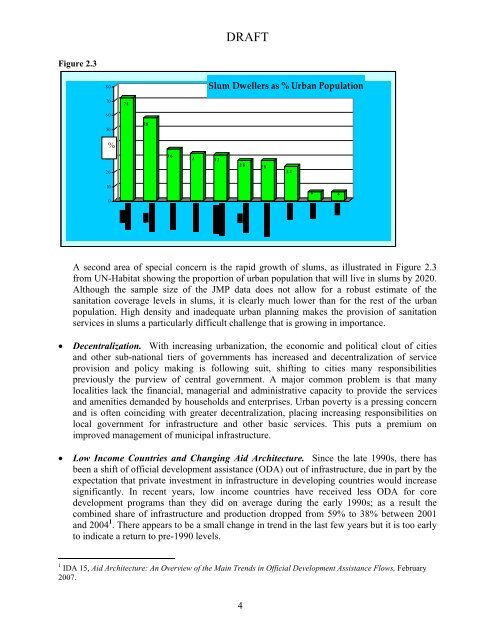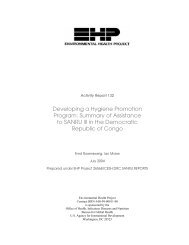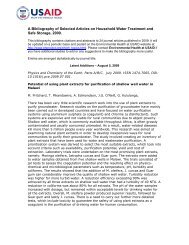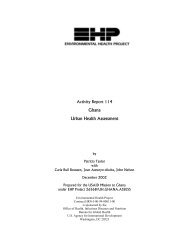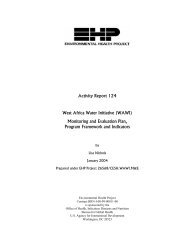DRAFTFigure 2.380 Slum Dwellers as % Urban Popul<strong>at</strong>ion707260505840%30203633 3228 28241006 6A second area of special concern is the rapid growth of slums, as illustr<strong>at</strong>ed in Figure 2.3from UN-Habit<strong>at</strong> showing the proportion of urban popul<strong>at</strong>ion th<strong>at</strong> will live in slums by 2020.Although the sample size of the JMP d<strong>at</strong>a does not allow for a robust estim<strong>at</strong>e of thesanit<strong>at</strong>ion coverage levels in slums, it is clearly much lower than for the rest of the urbanpopul<strong>at</strong>ion. High density <strong>and</strong> inadequ<strong>at</strong>e urban planning makes the provision of sanit<strong>at</strong>ionservices in slums a particularly difficult challenge th<strong>at</strong> is growing in importance.• Decentraliz<strong>at</strong>ion. With increasing urbaniz<strong>at</strong>ion, the economic <strong>and</strong> political clout of cities<strong>and</strong> other sub-n<strong>at</strong>ional tiers of governments has increased <strong>and</strong> decentraliz<strong>at</strong>ion of serviceprovision <strong>and</strong> policy making is following suit, shifting to cities many responsibilitiespreviously the purview of central government. A major common problem is th<strong>at</strong> manylocalities lack the financial, managerial <strong>and</strong> administr<strong>at</strong>ive capacity to provide the services<strong>and</strong> amenities dem<strong>and</strong>ed by households <strong>and</strong> enterprises. Urban poverty is a pressing concern<strong>and</strong> is often coinciding with gre<strong>at</strong>er decentraliz<strong>at</strong>ion, placing increasing responsibilities onlocal government for infrastructure <strong>and</strong> other basic services. This puts a premium onimproved management of municipal infrastructure.• Low Income Countries <strong>and</strong> Changing Aid Architecture. Since the l<strong>at</strong>e 1990s, there hasbeen a shift of official development assistance (ODA) out of infrastructure, due in part by theexpect<strong>at</strong>ion th<strong>at</strong> priv<strong>at</strong>e investment in infrastructure in developing countries would increasesignificantly. In recent years, low income countries have received less ODA for coredevelopment programs than they did on average during the early 1990s; as a result thecombined share of infrastructure <strong>and</strong> production dropped from 59% to 38% between 2001<strong>and</strong> 2004 1 . <strong>The</strong>re appears to be a small change in trend in the last few years but it is too earlyto indic<strong>at</strong>e a return to pre-1990 levels.1 IDA 15, Aid Architecture: An Overview of the Main Trends in Official Development Assistance Flows, February2007.4
DRAFTIn addition to the decline in ODA for infrastructure (including sanit<strong>at</strong>ion), two otherproblems affect low-income countries: large number of donors <strong>and</strong> lack of harmonizedapproaches. <strong>The</strong> number of bil<strong>at</strong>eral <strong>and</strong> multil<strong>at</strong>eral agencies which interact with recipientcountries has grown enormously. For instance, the average number of donors per countryrose from about 12 in the 1960s to about 33 in the 2001-2005 period. Furthermore, there arecurrently over 230 intern<strong>at</strong>ional organiz<strong>at</strong>ions, funds, <strong>and</strong> programs. This is accompanied bysignificant earmarking of aid resources for specific uses or for special-purpose organiz<strong>at</strong>ions,including global programs or “vertical” funds. Earmarking of ODA is still common in manybil<strong>at</strong>eral assistance programs.At the same time, a new trend th<strong>at</strong> has emerged is the assistance of Middle Income Countriesto poorer countries, although their focus has been mostly in energy, telecoms, <strong>and</strong> transport. 2China’s financing for African infrastructure is estim<strong>at</strong>ed to have exceeded $4 billion in 2006,a level comparable in scale to th<strong>at</strong> of all OECD-DAC members. <strong>The</strong> Arab developmentfunds have been contributing around $500 million per year to African infrastructuredevelopment, particularly in the road sector. <strong>The</strong>se new donors offer an opportunity to bringadditional resources to the sanit<strong>at</strong>ion sector, but harmonized approaches will be required tomaximize the long-term development impact of aid.2.3 Specific Challenges of the <strong>Sanit<strong>at</strong>ion</strong> SectorIn addition to the challenges described in the sections above, the sanit<strong>at</strong>ion sector has specificfe<strong>at</strong>ures th<strong>at</strong> make it most challenging among other infrastructure sectors. Some of these specificchallenges include:• Poor <strong>at</strong>tention given to sanit<strong>at</strong>ion. Dem<strong>and</strong> from users for better sanit<strong>at</strong>ion services is muchless than for other infrastructure services such as w<strong>at</strong>er supply, energy <strong>and</strong> roads. As aconsequence, the level of political <strong>at</strong>tention to sanit<strong>at</strong>ion is much lower, with few exceptionsth<strong>at</strong> require further analysis of its political economy dimension. <strong>Sanit<strong>at</strong>ion</strong>, as opposed toother infrastructure sector, suffers from fragmented administr<strong>at</strong>ive responsibilities amongministries <strong>and</strong> government agencies (ministries <strong>and</strong> agencies of w<strong>at</strong>er supply, environment,public health, <strong>and</strong> local government are, to some degree, responsible for sanit<strong>at</strong>ion, as well asmunicipalities <strong>and</strong> other sub-n<strong>at</strong>ional governments). In addition, sanit<strong>at</strong>ion is viewed bygovernment as a priv<strong>at</strong>e household issue, as opposed to most other infrastructure services.<strong>Sanit<strong>at</strong>ion</strong> arouses deep feelings <strong>and</strong> <strong>at</strong>titudes of disgust <strong>and</strong> is not a topic th<strong>at</strong> is discussedopenly in public in many cultures.• <strong>The</strong> cost of inaction. <strong>The</strong> lack of sanit<strong>at</strong>ion causes profound economic, health <strong>and</strong> socialimpacts, as illustr<strong>at</strong>ed in numerous studies th<strong>at</strong> will not be repe<strong>at</strong>ed in detail in this str<strong>at</strong>egicdocument. Diarrheal diseases have the largest contribution to the environmental burden ofdisease for children ages 0-14. Globally, about 3,900 children die everyday from diseasesassoci<strong>at</strong>ed with lack of access to basic sanit<strong>at</strong>ion <strong>and</strong> unsafe w<strong>at</strong>er supply. However, theeffective use of oral rehydr<strong>at</strong>ion therapy (ORT) has meant th<strong>at</strong> de<strong>at</strong>hs from diarrhea havegone done substantially but not the morbidity associ<strong>at</strong>ed with it <strong>and</strong> the malnutrition effects.2 Schur, M., von Klaudy, S., Dellacha, G., 2006, <strong>The</strong> Role of Developing Country Firms in Infrastructure: A NewClass of Investors Emerges, In: PPIAF Public<strong>at</strong>ion, No. 3, April 2006.5


